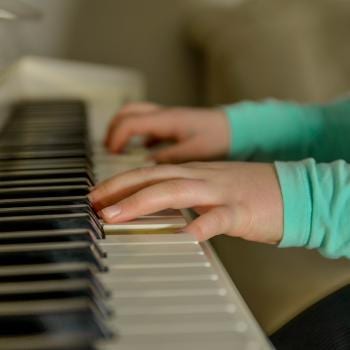Michael and Debi Pearl’s five children are now raising children of their own. Each says they are following the same methods their father laid out in To Train Up A Child, which he first published in 1994, and several of them have begun writing regularly for the No Greater Joy newsletter. As I read their articles, I often wonder whether they are adding their own spin to their father’s childrearing methods.
The Pearls have begun applying this three-part personality system to children. A recent article by the Pearls’ daughter Shalom Brand was titled “Three Types of Children, Part 2: Kisses and Tickles (Visionary/Dreamer Type).” As I read through this article, I wondered whether Shalom is amending her father’s methods in a few ways. I also, though, found myself horrified at the emotion control she preaches—emotion control also outlined in To Train Up A Child.
What can we do as parents to encourage our visionary/dreamer type kids? Face the fact that they are different. They don’t always follow the status quo. Let them dream, but direct the dreams. They are the actors and you are the director. Visionaries and dreamers need to express themselves, and our job is to guide them to productive ends.
This makes me cringe because of how almost there it is—and yet not there. Shalom admits that children are different, and that you should change how you relate to them in response to their individual personalities and needs. But the suggesting that the parent should direct the dreams of the dreamer child? That’s not how it works. I mean yes, children need guidance, but directing their dreams? That’s too much.
But let’s go on.
Laila, my visionary daughter, loves to draw and create works of art. Before I considered what type she was, I related to her more like her “Go-to” sister, Gracie. When one of Laila’s siblings caused her to mess up something she was drawing or creating, she would become angry and mad at them. I would discipline her for her anger, which did not work, for in her mind she had a right to get angry. She felt that her sister crossed into her space and caused her to mess up her art. By disciplining her, I was tearing her down, not building her up.
Finally! For a moment, it seems like Shalom gets it! She followed her parent’s methods, disciplining her daughter for being angry, and then realized that that was not working! She actually considered her daughter Laila’s perspective!
When I realized that she was a dreamer type, I began to see and understand her better and changed my tactic. I did not want her to respond in anger to her sisters and brothers, but I also wanted to build her up, not tear her down. So I sat her down and told her that her anger was wrong and from now on I was going to kiss and tickle her till the anger ran away, and if it still did not leave, I might have to give her anger a little switching.
She thought this was a great idea. I explained that the anger was hurting her and was not her friend and that we had to get it out of her heart and put the joy back in. I was building her up, helping her take control of what she thought was justified anger, and replacing it with laughter. After I had her happy again, I would then talk about what had caused the anger in the first place and help her figure it out. She soon learned to stop what she was doing and tell me that the anger was in her heart so I could run it off with kisses and tickles.
I . . . no.
But before we get to the real problem, is Shalom amending the methods taught in To Train Up A Child, or not? Shalom still advocates driving out a child’s anger, with a rod if need be, but she advocates using laughter and affection first and only using the rod if that doesn’t work. Michael, in contrast, always turns to the rod first. She also actually seems to consider her daughter’s feelings, although she then dismisses them. Michael doesn’t seem to consider children’s feelings except to ascribe diabolical motives to them.
But the really toxic thing here is the emotion control.
It is true that allowing anger to take control control causes harm. It is good that Shalom would talk to Laila about what caused her anger, though I do wonder what exactly “and help her figure it out” entails, and it is good that Laila became more self aware of her anger. But I’m still cringing at the level of emotion control. Shalom’s goal is to rid her child of anger, because it is anger that is the problem. She also does not appear to see Laila’s anger as legitimate.
Perhaps a contrast between Shalom’s approach and my own approach will help highlight the problem here. Sometimes my daughter Sally becomes angry when her toddler brother Bobby messes up her things. But rather than trying to eliminate that anger, I validate it. I don’t see anger as a problem. I focus instead on what caused that anger and on how to handle anger in a healthy manner.
“Sally, you are angry because your brother messed up your things. That would make me angry too! Remember, we do not hit people when we are angry. Bobby is not trying to be mean to you, he is just little and doesn’t know any better. What do you think you could do to fix the problem in a positive way?”
Sally then decides to move her craft project up to the table, or gets out a puzzle for Bobby so that he has something to do himself. If the problem goes on, I step in and deal with Bobby because Sally should have her things and her space respected. I don’t discipline Bobby, I redirect him. Depending on the situation, I may also try to explain to him not to mess with his sister’s things, before then involving him in another activity elsewhere. Sometimes what he really wanted was simply some extra attention.
My goal is not to eliminate Sally’s anger or to teach her that anger is wrong but rather to teach her how to handle her anger. Anger is not wrong. Sometimes anger is very very right. It is natural and right to be angry when someone wrongs you or walks all over you. What matters is how one handles that anger, and what that anger leads one to do. My goal is not to drive anger out of Sally’s heart but to teach her the very important skill of how to healthily deal with anger—which is not, by the way, to simply drive it out.
It may seem odd, but I think emotion control can be worse than physical violence. If a child is subjected only to harsh or abusive physical punishment, that child still has her feelings and her own internal world. But when discipline, whether physical or not, is used to control a child’s emotions, to dictate how a child is or is not allowed to feel . . . it is hard to explain just how just how horrific this is, or just how long its effects can last.














